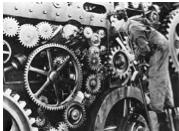Is the high velocity California job creation/destruction process slowing down?
Over the past few years at Fox and Hounds, we’ve discussed the enormous process of job creation/destruction in California, with roughly 250,000-350,000 jobs being created in an average month, and usually around an equal number being destroyed.
Recent data suggest, though, that this process might be slowing down. The rates of both job creation and job destruction, as percentage of total employment in California, have declined. The slowdown started prior to the Great Recession, and has continued after the Great Recession officially ended.
Below is a comparison of total jobs gained and lost in California in the second quarter of each year, for the alternate years from 1993-2011 (most recent state data).
| Quarter ended/Year | Total Job Gain in California | Percent Job Gain as % of total employment | Total Job Loss in California | Percent Job Loss as % of total employment |
| June 1993 | 890,912 | 8.6% | 907,181 | 8.9% |
| June 1995 | 999,294 | 9.4% | 913,062 | 8.6% |
| June 1997 | 1,069,632 | 9.4% | 1,000,962 | 8.8% |
| June 1999 | 1,070,808 | 8.4% | 958,849 | 9.5% |
| June 2001 | 1,062,993 | 8.4% | 1,204,829 | 9.5% |
| June 2003 | 980,555 | 7.9% | 978,642 | 7.9% |
| June 2005 | 958,792 | 7.5% | 923,985 | 7.3% |
| June 2007 | 940,379 | 7.3% | 960,532 | 7.4% |
| June 2009 | 762,554 | 6.3% | 957,683 | 8.0% |
| June 2011 | 829,483 | 7.0% | 779,015 | 6.6% |
Starting around 2003, even before the Great Recession, the pace of both job creation and destruction begin to decline. During the Great Recession, the total jobs created and percent of job gain went down sharply from 2007 through 2010. Even as the California economy picked up in 2011, the pace of both job creation and destruction remained lower than in the 1990s.
The decline is curious, since on other measures the California economy over the past decade seems to have increased in speed of job gains/loss and worker movement. The factors for this speeding-up have been discussed in previous Fox and Hounds postings: the changing work culture, the low level of private sector unionism in California, the expansion of globalization, and most of all the pace of technology gains.
Regarding technology gains, two researchers at the Massachusetts Institute of Technology, Erik Brynjolfsson and Andre McAfee, wade into the long running discussion on the impacts of technology on job gain/loss in their recent e-book, Race Against the Machine. They argue that what’s different today is the acceleration in the pace of technology. No longer is the economy able to create new jobs faster than jobs lost to technology.
Steve Saxton, chief of EDD’s Labor Market Information Division, suggests that it may be too soon to make any conclusions about longer-term job creation/destruction trends. He e-mails: “My read of the BED and other data is that employers and workers are exercising more caution over the past couple of years—workers less likely to move from one job to another and employers less inclined to open new businesses or hire new workers or lay off workers…In the second quarter of 2011 there were a few shocks to the world economy that created a great deal of uncertainty.” The most recent data only goes through 2011, and we still need to see how job creation/destruction has behaved in 2012.
I’d welcome hearing from others on the apparent decline in California’s job creation/destruction rates, in the face of a faster California economy.
In the meantime, our Fox and Hounds popular culture expert Donna Levin reminds us of this scene from the 1957 movie version of The Pajama Game, “Racing with the Clock” on the speeding up of the job world.


